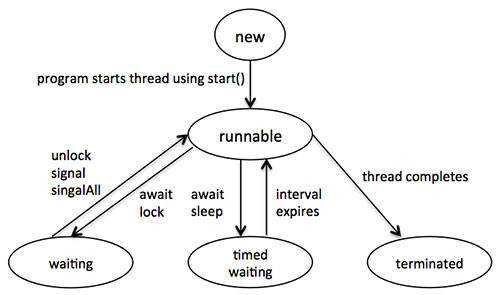Java provides built-in support for multithreaded programming. A
multithreaded program contains two or more parts that can run
concurrently. Each part of such a program is called a thread, and each
thread defines a separate path of execution.
A multithreading is a specialized form of multitasking. Multitasking threads require less overhead than multitasking processes.
I need to define another term related to threads: process: A process consists of the memory space allocated by the operating system that can contain one or more threads. A thread cannot exist on its own; it must be a part of a process. A process remains running until all of the non-daemon threads are done executing.
Multithreading enables you to write very efficient programs that make maximum use of the CPU, because idle time can be kept to a minimum.

Above mentioned stages are explained here:
A multithreading is a specialized form of multitasking. Multitasking threads require less overhead than multitasking processes.
I need to define another term related to threads: process: A process consists of the memory space allocated by the operating system that can contain one or more threads. A thread cannot exist on its own; it must be a part of a process. A process remains running until all of the non-daemon threads are done executing.
Multithreading enables you to write very efficient programs that make maximum use of the CPU, because idle time can be kept to a minimum.
Life Cycle of a Thread:
A thread goes through various stages in its life cycle. For example, a thread is born, started, runs, and then dies. Following diagram shows complete life cycle of a thread.
- New: A new thread begins its life cycle in the new state. It remains in this state until the program starts the thread. It is also referred to as a born thread.
- Runnable: After a newly born thread is started, the thread becomes runnable. A thread in this state is considered to be executing its task.
- Waiting: Sometimes a thread transitions to the waiting state while the thread waits for another thread to perform a task.A thread transitions back to the runnable state only when another thread signals the waiting thread to continue executing.
- Timed waiting: A runnable thread can enter the timed waiting state for a specified interval of time. A thread in this state transitions back to the runnable state when that time interval expires or when the event it is waiting for occurs.
- Terminated: A runnable thread enters the terminated state when it completes its task or otherwise terminates.
No comments:
Post a Comment